The appearance of cone-shaped flesh-colored tumors in the genital area is a cause for concern, which is entirely justifiable, since the health of the genital area is an important point in physical and moral health. a person's overall virtue.
These warts grow to cause discomfort, interfere with a normal sex life, and can also cause more serious health problems. If the integrity of the wart is compromised, infection can occur and malignant transformation can occur. Therefore, the desire to get rid of such manifestations is understandable and quite natural.
The reason appeared
The cause of papilloma warts is the human papilloma virus. This virus contains a certain set of DNA that successfully integrates into the cells of the human body and causes them to change their development cycle, shape and structure.

According to the international classification of diseases ICD-10, human papillomavirus is coded as B97. 7. Genital warts of a venereal nature are assigned code A63. 0.
There are many different strains of the virus, each of which causes specific warts. The type of virus determines the pathological process, symptoms, site of manifestation and severity of complications.
Strains are divided into two main categories:
- skin, with a predominant appearance in the dermis;
- mucous membrane appears on the mucosal epithelium of genital organs, oral cavity, etc. v.
In addition, papillomavirus types differ depending on the risk of degeneration from carcinogenic to carcinogenic, moderately carcinogenic and non-carcinogenic.
Usually, several different strains are present at the same time in the body of an infected person.
Path of infection and risk factors
There are several ways for pathogens to enter the body:
- "Vertical" drive. This is the name given to the transmission of infectious agents from mother to child during pregnancy. It is currently unknown whether the infection occurred during the prenatal period or directly during childbirth, but it is undesirable to perform a cesarean section on a mother infected with papillomavirus. Caesarean section is only chosen in cases where the papilloma is bleeding inside the birth canal.
- Sexual path.Infectious agents can enter the body during vaginal, oral or anal sex. Pathogens are also transmitted through saliva when kissing. Using a condom during sex does not guarantee protection against the virus, but it does make transmission of the virus less likely.
- Family way.The mechanism of transmission of this disease is quite rare. Infection can occur through contact with the patient's personal items. Because the virus is present in saliva and urine, you can become infected by using dishes, towels, personal hygiene items, from the edge of a toilet, or in someone else's bathroom.
The method of infection is mainly determined by the age of the person: in newborns, with a high degree of certainty, it can be determined that the infection was from the mother, and in older children, by contact andcontact in the family. From the age of 17, in most cases, sexual transmission occurs.
According to statistics, human papillomavirus is present in the body of more than half of the sexually mature population, but in most cases it does not manifest itself in any form and is present in a transported form. .
The peak of the disease occurs at the young age of 17 to 25 years old. This is due to maximum sexual activity and high sensitivity of the epithelium on the organs of the genitourinary system.
Risk factors that increase the likelihood of getting the disease are:
- early onset of sexual activity;
- change sexual partners frequently;
- age up to 25 years;
- having sex with people who have previously had human papillomavirus or other sexually transmitted diseases;
- pregnancy;
- Vaginal flora imbalance;
- any chronic illness;
- Endometrial optimism;
- treatment with cytostatic drugs or glucocorticosteroids;
- overweight;
- thyroid disorders and disruption of insulin production;
- vitamin deficiency.
Frequent stress and non-compliance with the principles of personal hygiene significantly increase the likelihood that a person, after entering the body, the infection will enter the active stage.
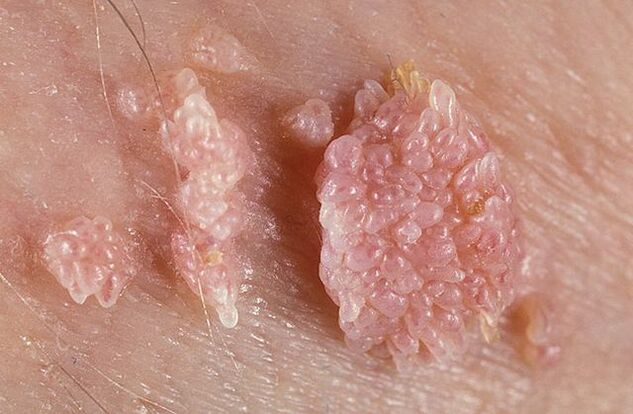
After entering, the virus spreads throughout the body through the bloodstream, attaches to cells, penetrates their structure and integrates its DNA into the cell's DNA. The affected cells then begin to actively grow and divide, due to which tumors appear.
Development path
After entering the human body, the virus does not cause any symptoms for a certain period of time.
The course of the disease occurs according to the following algorithm:
- Hidden period. During this stage, the carrier is not aware of the presence of the infectious pathogen because there are no clinical manifestations. However, at this stage, a person is already infectious and can infect his or her partner through sexual contact. This latent period can last from 2-3 months to several years.
- The onset of the disease occurs when the virus multiplies in sufficient quantities in the body or when the immune system's protective mechanisms weaken. During this time, the first symptoms appear.
- Active development with increasing symptoms.
The further course of events is developing in one of the following directions:
- spontaneous recovery with complete disappearance of papilloma warts (most often observed after the end of pregnancy);
- slow process and lack of development of skin tumors;
- active dynamics of papillomas with an increase in shape, size, number and fusion of groups located close to each other;
- degeneration of benign tumors into malignant ones.
Types of genital warts
There are several common types of condyloma papillomas:
- exogenous- protrusion on the surface of the skin or mucous membrane with preferential growth outward;
- endogenous- with growth mainly deep into the skin structure, therefore less noticeable on visual inspection;
- Buschke-Levenshtein Education- characterized by rapid growth, large size and frequent recurrence after a course of treatment. With this form, both external growth and damage to deep internal tissue layers occur.
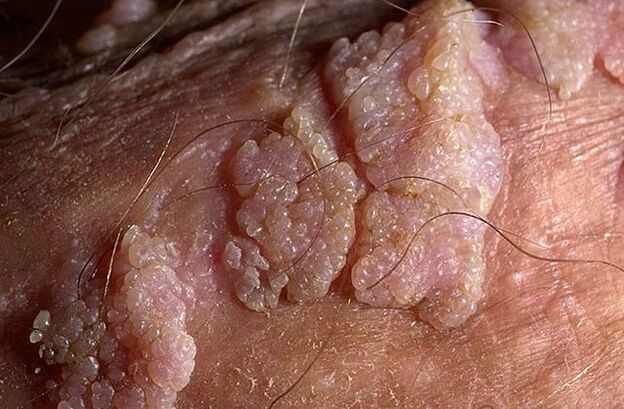
Genital warts can have a thin or wide base. If the stem is thin, the tip may be pointed or club-shaped. Papillomas with a broad base are quite rare. The color of all such growths closely resembles the color of the skin: from flesh to pink. The surface can be soft or covered with a layer of keratin.
Warts can appear singly or in groups that resemble papules. Sometimes many such groups reach a size of 1. 5 cm. When several groups merge, the formations look like cauliflower inflorescences or rooster combs. These growths make it easier to identify the disease during examination.
Single growths usually do not cause as much discomfort as large particles. In rare cases, they rupture and bleed slightly.
Large tumors are more problematic: they can get wet, bleed, and become aggravated by secondary infections that take root in the affected areas.
Symptom
The first symptoms appear after the completion of the latent period, which in the shortest cases lasts several weeks.
The appearance of condyloma occurs as follows:
- The skin appears slightly red and begins to itch;
- rash appears on the skin or mucous surfaces in the form of small blisters or bumps;
- The nodules gradually increase in length to 1-1. 5 cm;
- New rashes appear nearby, which also turn into papules.
Localization depends on the specific strain and the place of entry of the pathogen into the body:
- external genitalia;
- anal area (anogenital papilloma);
- inside the urethra;
- on the cervix;
- on the oral epithelium (on the surface of the cheeks, tongue and inside of the lips).
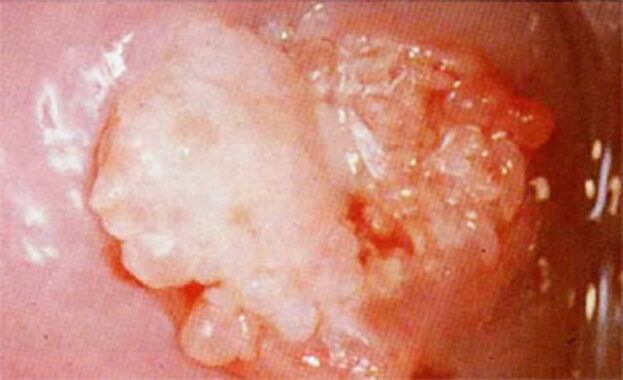
The clinical picture may vary in each specific case depending on the patient's health condition. For small warts, no other symptoms can be observed.
With a more severe process, the following accompanying symptoms are observed:
- itching or burning at the rash;
- feeling of a foreign object in the perineum;
- humidity in the area where the tumor is;
- unpleasant odor from the area where the wart is.
During physical activity, long walks or runs, all of the above symptoms will increase.
In severe cases, fatigue, weakness, signs of intoxication, persistent headaches, fever and high temperature may occur.
In men and women, symptoms have some differences. This is due to anatomical differences and characteristics of sexual behavior.
Symptoms in men
Condylomas in men often affect the scrotum, groin, pubic bone and various structural parts of the penis: head, shaft, frenulum and prepuce, coronal groove. When localized near the urethra, the papilloma has a distinct red color and this location often causes branching or splashing during urination.
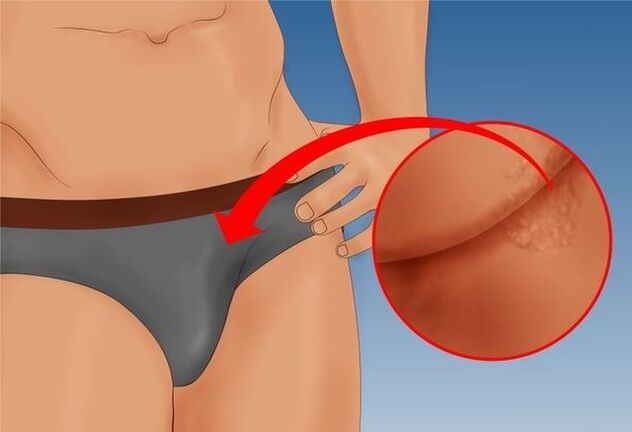
If the rash is located at the exit of the anus, severe pain may occur during bowel movements and there may be blood in the stool. Therefore, the fear of defecation reflex often appears, causing periodic constipation and sometimes hemorrhoids.
There is often a vague feeling of pain in the lower abdomen, a burning and painful feeling during sex, as well as when urinating.
Prolonged infection reduces a man's immunity, making him more susceptible to respiratory diseases and more difficult to treat than usual.
Symptoms in women
The most common places for papillomas to occur in women are the perianal areas, where moisture and temperature are constantly increasing: the epithelium of the clitoris, labia, vaginal opening and urethral meatus. If infection occurs during anal sex, a growth ring may gather around the anus.
Large tumors often develop secondary infections, causing a strong odor, bleeding, ulceration, and severe pain when touched. While walking, severe irritation and discomfort may be observed.
In 50% of women, white elements form on the cervix, detected during routine colposcopy, before which they are treated with acidic antiseptics that can increase the white color of the pimplestoad.
In some cases, the tumors are all located on the mucous membrane of the woman's internal genital organs, so she does not notice them until a scheduled visit to the gynecologist. This is often the reason men have to start treatment later.
Often, women feel embarrassed by the presence of objects in intimate places, causing them to refuse sex.
Rarely papillomas occur in the mouth, and in extremely rare cases - in the pubic bone, thighs, neck or face.
Characteristics of condylomatosis during pregnancy
If genital warts have been treated, pregnancy should be planned no earlier than a few months. Abstinence during pregnancy will be longer if the woman takes antiretroviral drugs during treatment. After successful treatment and maintenance of treatment intervals, you can safely become pregnant.
If the disease is detected during pregnancy, treatment should wait until all the baby's organs are formed. Treatment after 28 weeks does not cause developmental abnormalities in the fetus.
The reasons why condylomatous warts appear in pregnant women include a standard decrease in immunity with increased stress on the body and significant hormonal fluctuations.

If the papilloma is located on the external part of the genitals or in the perianal area and does not cause discomfort, treatment can be postponed until after the baby is born. But in case the tumor grows rapidly, increases in size and causes severe pain as the tumor grows, you should consult a doctor immediately. Sometimes, with high growth rates of formations, their loosening is observed, which can lead to vaginal rupture.
This disease, as a rule, does not affect the formation of the fetus, but its influence extends to the mother's condition and the birth process. If other infections are present, there is often a risk of premature birth.
When uterine fibroids are damaged during the passage of the fetus through the birth canal, this often leads to infection of the baby and laryngeal fibroids in the newborn or thoracic stage. Therefore, the presence of significant papillomas in the birth canal is a direct indication for cesarean section.
If necessary, the tumor will be removed during pregnancy, after which the tissue will be sent for histological testing to verify its benign nature.
The use of traditional medicine methods to remove warts during pregnancy is unacceptable, since this not only will not give a positive result, but can also give rise to degeneration of the cells. benign cells into malignant cells.
Lumps that do not cause discomfort during pregnancy usually go away without treatment within a few months after childbirth as the woman's hormonal balance returns to normal.
Diagnose
If the patient notices symptoms reminiscent of human papillomavirus, then he needs to contact a gynecologist, urologist or vein specialist.
First of all, experts conduct surveys to clarify the following points:
- when the patient first detected symptoms;
- Possible cause: infection;
- the dynamics and development of the disease until you see a doctor.
Then a clinical examination is performed, during which the specialist determines the location, intensity, size and condition of the growths. For women, perform additional colposcopy (examination of each genital organ with magnification) or extended colposcopy (a similar procedure using acetic acid solution).
For a more accurate diagnosis, doctors prescribe the following additional tests:
- PCR diagnosis, allows you to detect the pathogen in scratches from the epithelium of the affected areas and determine its quantity (also allows you to determine the strain of the virus);
- Endoscopic- visual inspection of the area near the anus with a magnifying glass;
- cytology and histologyfragments formed to identify atypical cells or tissues;
- growth biopsyfrom epithelial tissues to study tissue structure using a microscope;
- detect antibody titerswith this virus;
- smearfrom the cervical canal and cervix to study cancer cells using a microscope.
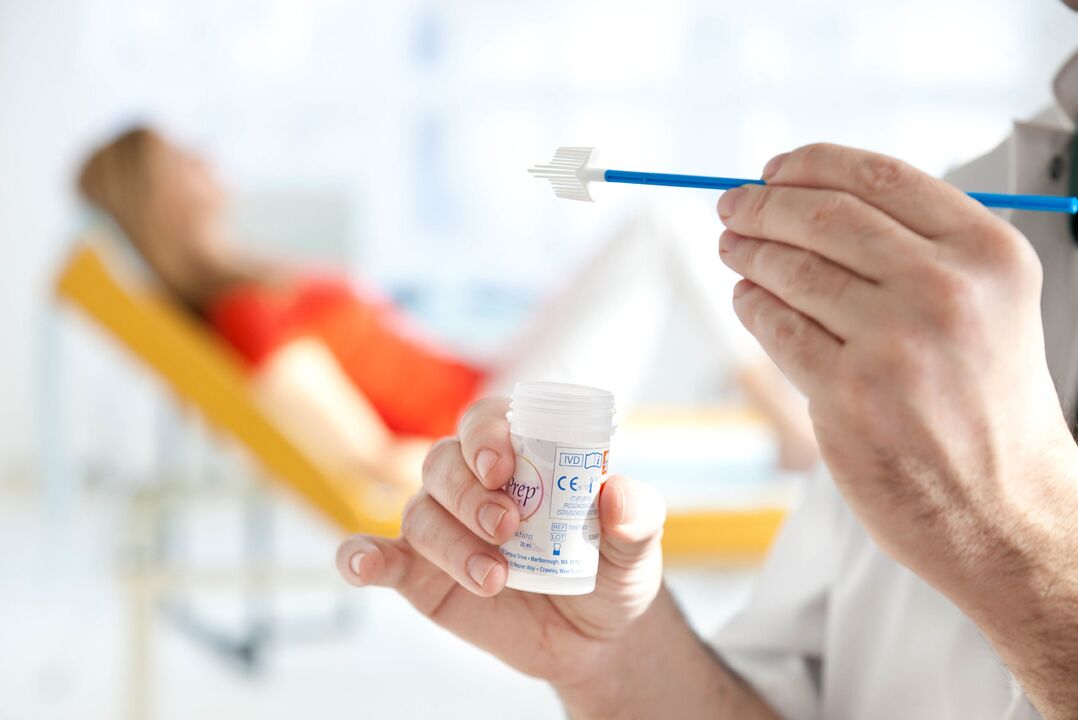
If necessary, schedule a consultation with a dermatologist or colorectal specialist. If the diagnosis is made on a pregnant woman, an obstetrician-gynecologist should be contacted.
After receiving all the necessary data, the specialist can choose individual treatment tactics and help relieve the disease.
Treatment
Usually, with genital warts, people avoid going to medical facilities and choose their own treatment, giving priority to topical drugs that can eliminate obvious symptoms but do not cure the body. infection, moving into the latent stage. Such treatment almost always leads to relapse. Therefore, for a final cure, an integrated approach is needed, which only a specialist can determine.
Treatment is carried out in the following areas:
- remove growth;
- fight against viruses;
- Enhance the patient's immunity.
All methods used to combat genital warts are divided into radical and medicinal.
Basic method
Such methods are chosen if urgent removal of external manifestations is needed or when warts are localized on the cervix in women.
The following methods are used for removal:
- Surgical excisionformed using a scalpel under local or general anesthesia. The cut site is sutured with surgical thread. Although this method is considered classical, it often causes bleeding after surgery and requires long rehabilitation in the hospital, so recently surgical excision is less and less used.
- Cryodestruction with liquid nitrogen.This method is relatively inexpensive and safe, and does not require anesthesia or sedation. After freezing, the formed protein is destroyed, the spots dry and fall off. After a few weeks, there are no scars or scars left at the treatment site.
- Laser removal.Although safe and highly effective, this method requires anesthesia and is characterized by high cost, so it will be indicated if other methods cannot be used. When exposed to a laser beam, the structure of the growth stem is destroyed. After burning, the wart is deprived of nutrition, which within a few days will lead to necrosis and the scab will disappear. Scars often remain after laser removal.
- Burn electricity.This method is affordable but very painful so requires local anesthesia. Genital growths are exposed to high temperatures, during which the papillae are burned. After a few days the scab will fall off on its own, leaving a scar.
- Radiosurgery.Currently, this is the most high-tech, fast and effective method, which determines the high cost. Using high-frequency radio waves, genital warts are painlessly removed in 15-30 minutes. After such removal there is no bleeding, wound healing occurs within a day, after which no traces remain on the skin.
- Chemical destruction.This technique is only suitable for small squads, without much consolidation. Special strong substances are used, which lead to the death of growing cells. These products are based on high concentrations of acid or alkali that cause localized chemical burns.
If we limit ourselves only to radical methods of combating pyoma, then recurrence of pyoma will occur in every third case.
Drug treatment
An integrated approach includes the removal of benign tumors, the elimination of viruses in the body and the strengthening of immune status. Therefore, drug treatment includes the use of such drugs:
- Pharmaceutical productsTo treat wart necrosis, can be used at home. Over several days, this product should be applied in spots to the wart. If the medication comes into contact with healthy tissue near the growth, a deep chemical burn will form, so you need to apply the medication very carefully. After daily application, take a short break of a few days. If the bud does not fall off, the process is repeated. Pharmaceutical products that cause necrosis of tumor growth include solutions and ointments.
- Antiviral drugs.They can be used locally or systemically.
- immune regulationto improve immunity.
In addition, to improve the body's defenses, systematic supplementation with multivitamin complexes, a special diet and a healthy lifestyle are prescribed.
Immunity to uterine fibroids is not developed after treatment, so reinfection from a previous sexual partner is possible.
Complications may occur
If left untreated for a long time, genital warts will cause the following complications:
- The attachment of bacterial infection to the damaged epicondyloma, leads to pus formation, inflammation of the foreskin and ulceration in the perianal area.
- When tumors grow in the urethra, bacterial urethritis can develop, leading to problems with urination, urinary retention, and urinary tract infections.
- When large tumors are localized in the anus, hemorrhoidal bleeding and pericarditis occur.
- Genital warts can affect a person's sex life, causing him to refuse to have sex. All this often leads to depression and psychological problems.
- Women may experience cervical erosion and dysplasia.
- The biggest danger is the risk of benign tumors degenerating into cancer (cancer of the head of the penis or cervix).
Precautions
Prevention of condylomatosis is divided into specific and general.
Specific preventive measures include vaccination with the new quadrivalent vaccine. These vaccines do not work against all strains of human papillomavirus, but they are successful against the most dangerous type that causes cervical cancer. Vaccination is carried out from the age of 11 and is repeated three times.
Non-specific prevention is similar to the measures inherent in many sexually transmitted diseases:
- use barrier contraceptives;
- personal hygiene at an appropriate level;
- regular sexual partners;
- regular examination by a gynecologist or internist;
- Timely treatment of diseases of the pelvic organs;
- quit drinking and smoking.
Additionally, stress, physical fatigue, hypothermia, and any factors that weaken the immune system should be avoided. A healthy diet, improved health and regular sleep will help prevent the appearance of genital warts.














































































